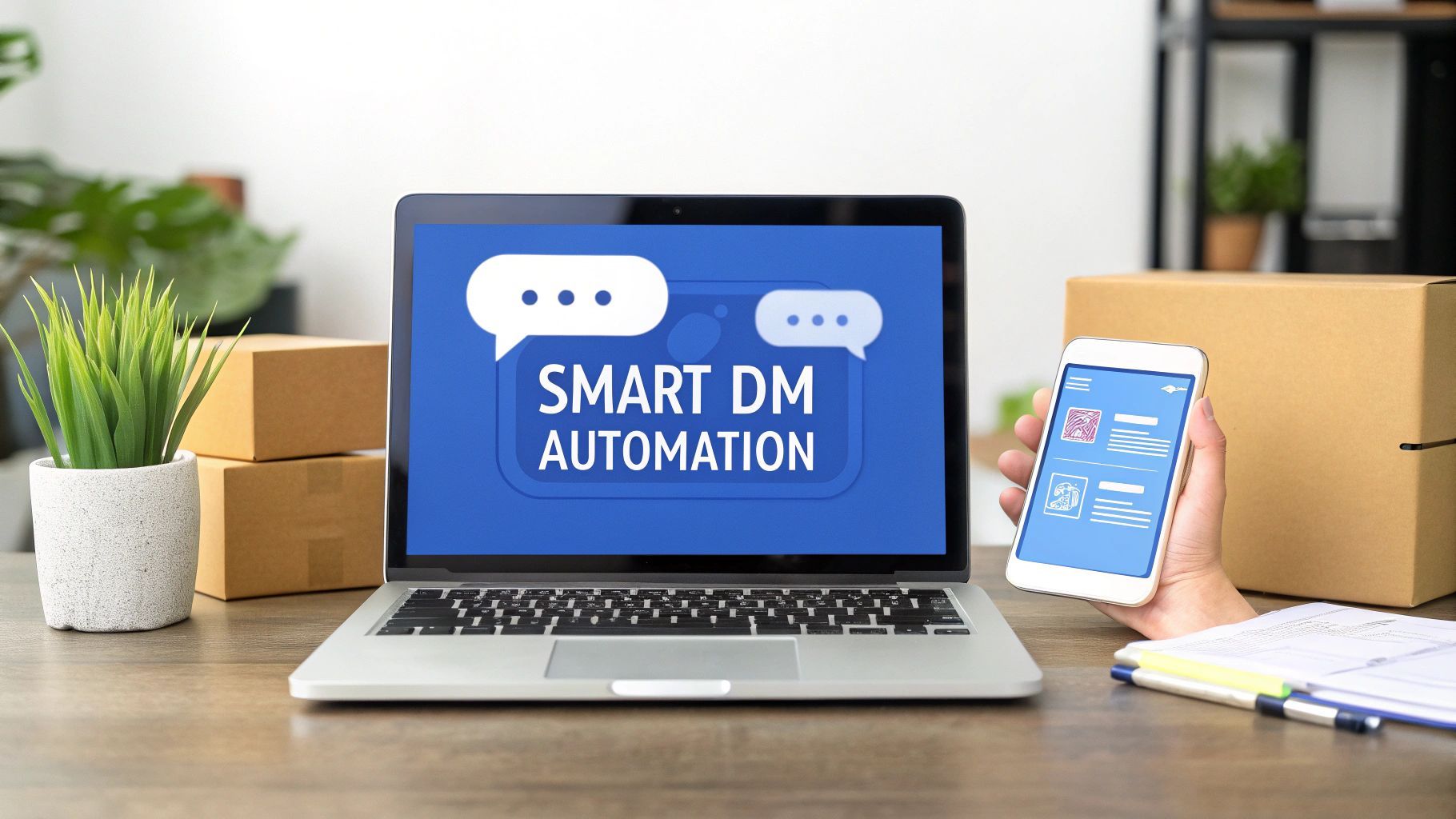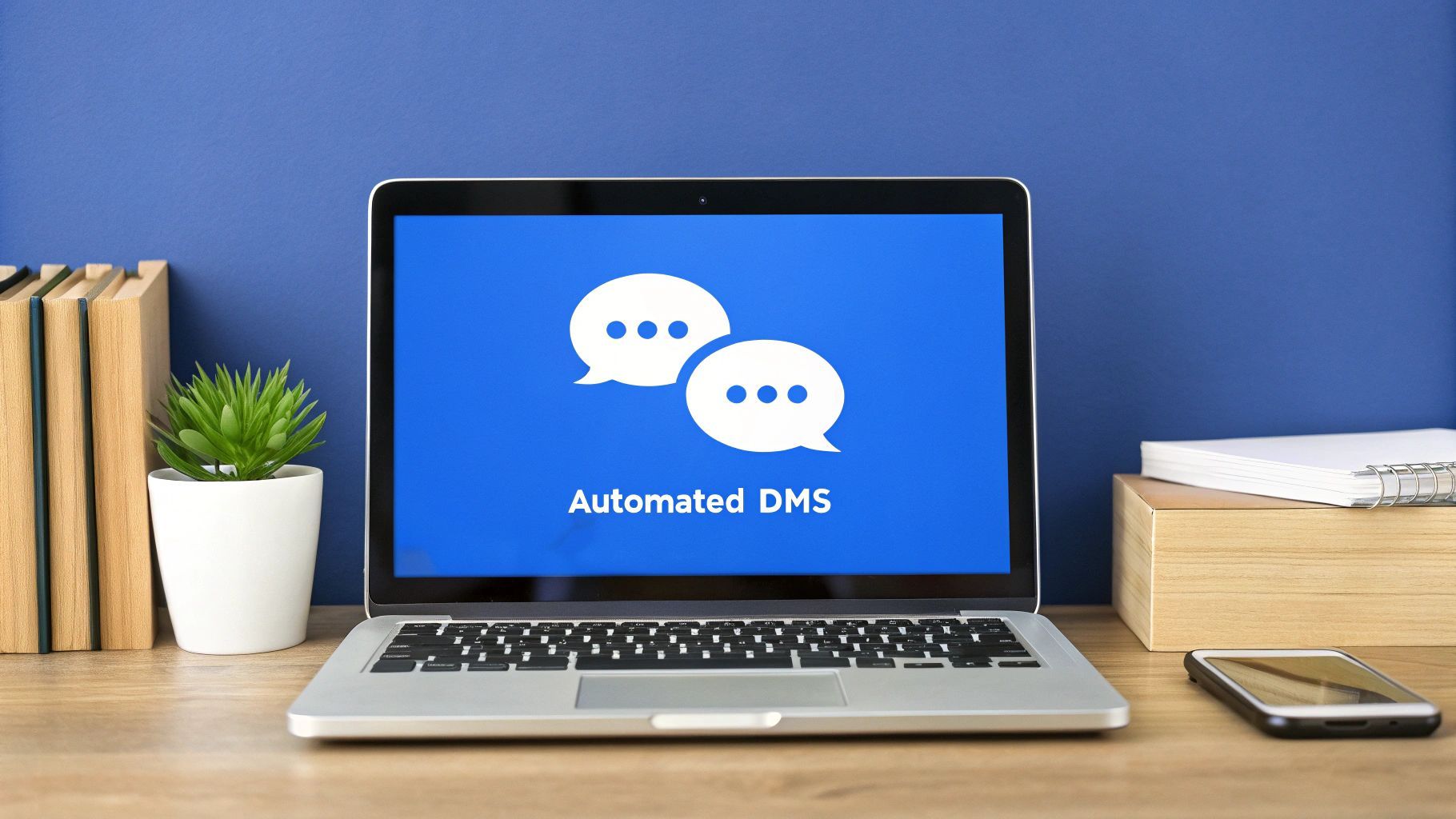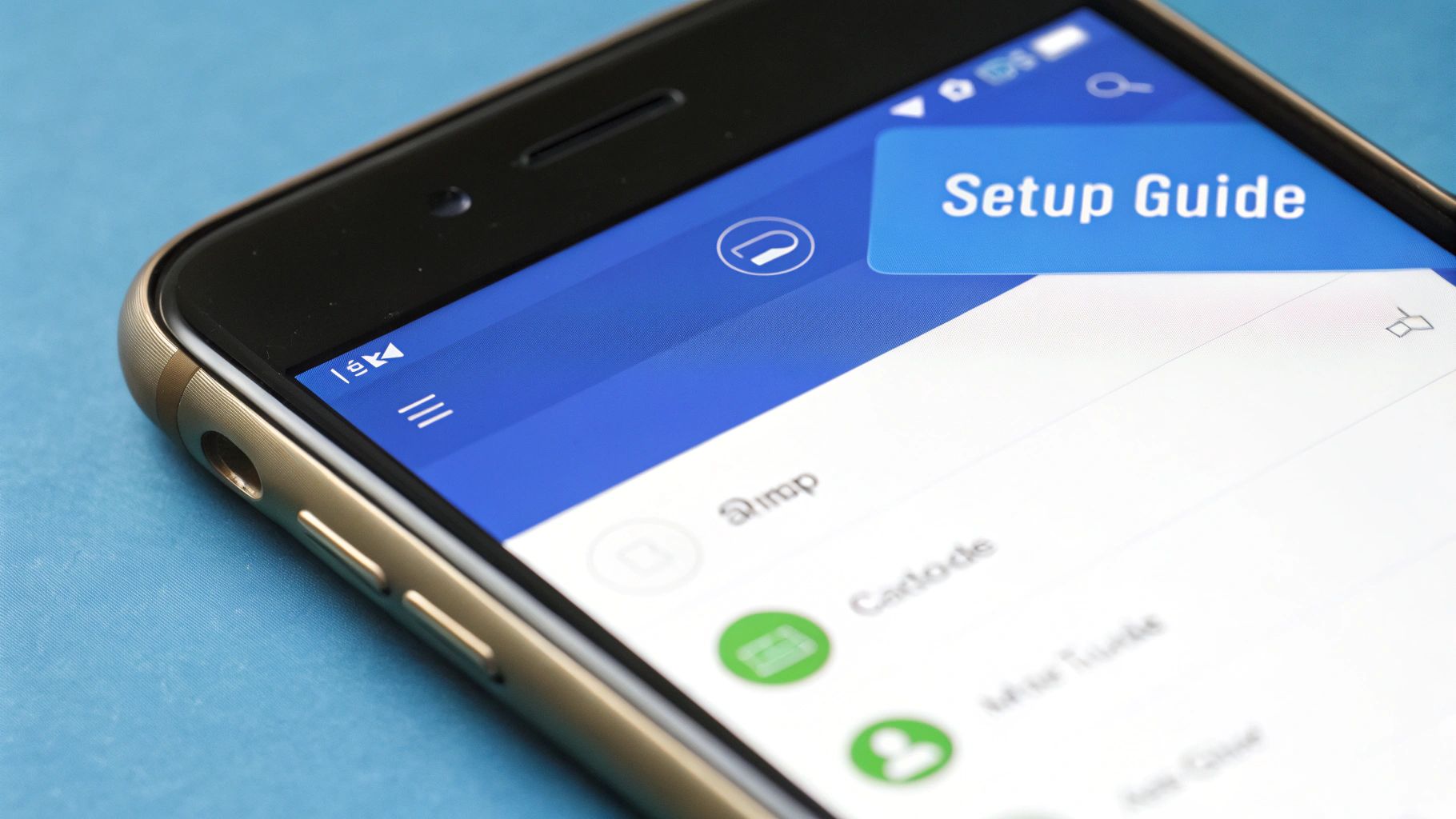
Automated Direct Messages Your Customers Will Love
Discuss with AI
Get instant insights and ask questions about this topic with AI assistants.
💡 Pro tip: All options include context about this blog post. Feel free to modify the prompt to ask more specific questions!
Automated direct messages are simply pre-written messages that get sent automatically when a user takes a specific action, like buying a product. But don't think of them as spam. Instead, picture them as a smart, efficient way to kick off meaningful conversations at scale, making sure every customer feels seen at just the right moment.

Forget any ideas you have about clunky, impersonal bots. The best automated direct messages feel more like a perfectly trained team member who never takes a break. They operate across email, SMS, and social media DMs to deliver timely, relevant, and surprisingly human-like messages that would be impossible to keep up with manually.
The whole point isn’t to replace real connection but to start it. By automating those first touchpoints, you free up your team’s time to focus on the more complex and high-value conversations that truly need a human.
At its core, the system runs on a simple "if this, then that" principle. A customer's action acts as a trigger, which then sets off a pre-planned messaging sequence. This creates an experience that feels both immediate and personal.
Think of it like a digital tripwire. When a customer takes a specific action, they "trip the wire" and set off a chain of events. That’s the magic behind automation.
- Triggers: These are user actions that initiate a workflow. A trigger could be anything from someone subscribing to your newsletter, making their first purchase, or commenting on your latest Instagram post. (Note: Some platforms have limited trigger capabilities depending on their API support.)
- Workflows: This is the series of messages that follows a trigger. A workflow can be as simple as a single "Welcome!" message or as complex as a multi-day email sequence designed to nurture a new lead or recover an abandoned cart.
This trigger-and-workflow combo is the engine that drives great automation. It ensures the right message finds the right person at the exact moment they’re paying attention. And the results are pretty stunning; automated emails see 70% higher open rates and 152% higher click-through rates than standard campaigns. For more advanced workflows, the numbers are even wilder, boosting conversion rates by up to 2,361%. If you're curious, you can dig into more stats on the power of email automation from amraandelma.com.
An automated direct message isn't just sending a message; it's responding to a customer's action. This shift from broadcasting to reacting is what makes the communication feel personal and valuable rather than intrusive.
To really see the difference, let’s compare the old way with the new. Trying to message every person by hand isn't just slow—it’s a bottleneck that actively holds back your growth. The table below breaks it down.
Aspect Manual Direct Messages Automated Direct Messages Speed Slow, dependent on human availability Instant, 24/7 responsiveness Scale Limited to a few conversations at a time Handles thousands of interactions simultaneously Consistency Tone and information can vary by agent Perfectly consistent brand voice and accuracy Data Use Relies on manual lookup and memory Leverages real-time data for personalization Cost High labor costs for dedicated staff Low operational cost, high ROI
Ultimately, automation is about doing what was previously impossible: building genuine relationships with every single customer, no matter how big you get. It’s a system for welcoming, guiding, and supporting people, setting the foundation for real loyalty and long-term growth.
When you see a really effective automated message in action, it can feel like magic. A user does something, and instantly, the brand responds with the perfect message. But it’s not magic. The secret is that powerful automation isn’t complicated; it's just a simple, logical sequence that creates a timely and relevant conversation.
If you peek behind the curtain, you’ll find that every smart automation is built on three basic components working together. Once you get a handle on these, you can start building automated direct messages that feel genuinely helpful, not robotic.
These core pieces are the trigger, the action, and the workflow. Think of it as a simple "if this happens, then do that" recipe. When you master this concept, you can design some seriously effective customer experiences, all without writing a single line of code.
Every single automation has to start somewhere. That starting point is the trigger—a specific event or user behavior that kicks off the whole process. It's the starting pistol that tells your system, "Okay, it's go time!"
Crucially, a trigger isn't something you do; it's an action taken by a customer or follower. This is exactly what makes the whole thing feel so personal and responsive. The message shows up because the user did something first, so it feels like a natural reply, not a random, spammy interruption.
Some of the most common triggers are things like:
- A shopper abandons their cart on your site.
- A new subscriber signs up for your email list.
- A user mentions your brand in their Story.
- Someone drops a comment on your latest post.
Each of these moments is a golden opportunity to connect. The trigger makes sure your message arrives with perfect timing, right when that person is actively thinking about your brand.
As soon as a trigger fires, the system performs an action. This is the "what" of your automation—the specific task you want to get done. In most cases, the action is sending a pre-written direct message, but it can be other things, too.
For example, if the trigger is an abandoned cart, the action is to send a gentle reminder with a link to get them back to their items.
The real power of the trigger-action relationship is its speed. An automated system can fire off an action in a fraction of a second, creating a seamless experience that would be impossible for a human to manage at scale. That kind of responsiveness really shows customers you're paying attention.
A single trigger and action can be useful, but the real potential is unlocked when you build a workflow. A workflow is more than just one message; it's a planned-out series of timed actions that guides a customer on a journey. It’s a strategic sequence designed to hit a specific goal, like winning back a lost sale or warming up a new lead.
Let's go back to that abandoned cart example:
- Trigger: A customer leaves your site with items still in their cart.
- Action 1 (1 hour later): Send a friendly DM. "Hey, did you forget something?"
- Action 2 (24 hours later): Follow up with an incentive. "Still thinking it over? Here's 10% off to help you decide!"
- Action 3 (3 days later): Send one last message asking for feedback. "Was there an issue with checkout? Let us know how we can help."
This series of automated messages creates a thoughtful, persistent, and helpful experience. It gently nudges the customer toward making a purchase without being pushy. Each step is a logical next move, turning a simple notification into a complete, goal-oriented strategy. This is where automation stops being a simple tool and becomes a real growth engine for your business.

It’s one thing to talk about automation in theory, but it’s another thing entirely to see it actually drive results. When you move from concept to practice, automated direct messages stop being just an efficiency tool and become a real engine for growth, sales, and stellar customer experiences.
Whether you're running a busy e-commerce shop or managing a flood of support tickets, the right automation playbooks can completely change how you connect with your audience. These aren’t just random, robotic messages. They are smart, strategic sequences built to solve problems, delight customers, and steer them toward a specific goal.
Let's dive into the most effective ways businesses are using this technology right now. Each use case tells a story of how a well-timed, automated message can turn a simple touchpoint into a valuable, revenue-generating relationship.
For any online store, the customer journey has key moments where one message can make or break a sale. Automated DMs let you show up at every single one of those moments. They can turn window shoppers into loyal customers and one-time buyers into brand advocates. In fact, smart automation is a core part of effective business process optimization, making sure no opportunity slips through the cracks.
Here are three battle-tested e-commerce playbooks:
- The Welcome Series: When someone subscribes to your email list, their interest is at its peak. An automated welcome message can build an instant connection and introduce your brand in a structured way.
- The Abandoned Cart Sequence: This is the ultimate sales-saving tool. When a shopper adds items to their cart but leaves without buying, a timely workflow can send a friendly reminder. It can also tackle common roadblocks, like shipping costs, or even offer a small incentive to nudge them over the finish line. This one automation can claw back a huge chunk of otherwise lost revenue.
- Post-Purchase Follow-ups: The relationship doesn't end after the "buy" button is clicked. A post-purchase automation can send shipping confirmations, provide tracking updates, and—most importantly—ask for a review after the product has been delivered. This builds trust and generates the powerful social proof needed to convince future buyers.
These automations are so effective because they perfectly match the customer's actions, giving them exactly what they need, precisely when they need it.
In the world of customer support, speed and accuracy are everything. Customers want answers now, and your team needs a way to handle the constant flow of questions without getting buried. Automated direct messages are your first line of defense, creating a support system that’s both instant and intelligent.
By automating the initial responses and handling all the common, repetitive questions, support teams can finally focus their energy on the complex, high-stakes issues that genuinely need a human touch. This means faster resolutions for everyone and a major boost in customer satisfaction.
Here’s how automation can completely reshape your support process:
- Instant FAQ Resolution: You can set up an automation to recognize and immediately answer frequently asked questions like, "Where is my order?" or "What's your return policy?" The system can even pull live order data from your Shopify or WooCommerce store to give a personalized, accurate answer, 24/7.
- Intelligent Ticket Routing: Not every question has a simple automated answer. For more complicated or sensitive issues, the system can ask a few clarifying questions to figure out the problem. Then, it can automatically route the ticket to the right person or department, whether that's billing, technical support, or sales.
- Proactive Status Updates: Keep customers informed without lifting a finger. An automation can send out proactive updates on a support ticket—letting them know it's been received, is being reviewed, and has been resolved. This level of transparency dramatically cuts down on all those "Just checking in..." follow-up messages.
By putting these workflows in place, businesses can slash their ticket volume, dramatically reduce response times, and free up their agents to do what they do best: solve unique problems and build lasting customer relationships.

Sure, email and social media have their place, but when you need to get a message to someone right now, nothing beats SMS. Think of it as the express lane in your communication toolkit, built for speed and impact.
Its power comes from its raw immediacy. An email can sit in an inbox for hours, even days. A text message, on the other hand, lands with a personal, urgent buzz that’s almost impossible to ignore. This makes it the perfect channel for high-value, time-sensitive automated direct messages.
When a customer absolutely needs to know something, SMS is how you reach them. This direct line into their pocket is incredibly powerful, but with great power comes great responsibility. You have to earn the right to be there.
Because a text feels so much more personal than an email, the rules for using it are much stricter. You can’t just start texting people; you need clear, provable permission. This isn’t just good manners—it’s a legal must-have in most places.
- Explicit Opt-In Is a Must: Your customers have to knowingly and willingly agree to get texts from you. This is usually handled by having them text a keyword to your number or check a clearly marked box during checkout. No ambiguity allowed.
- Set Clear Expectations Upfront: When they sign up, tell them exactly what kind of messages you’ll be sending and roughly how often. Being transparent from day one builds a foundation of trust.
- Always Provide an Easy Exit: Every single message must include a simple way to opt out, like replying with "STOP." Honoring these requests immediately is non-negotiable for keeping your brand in good standing.
The sheer growth of SMS as a business tool shows just how much people appreciate this direct connection. The global SMS marketing industry is on track to jump from $70 billion in 2020 to an estimated $92 billion by 2025. That growth is fueled by people wanting in; an incredible 84% of consumers will have opted in to receive business texts by 2025.
The trick to great SMS automation is to reserve it for messages that offer instant value. This isn't the channel for your weekly newsletter or a "just browsing" promo. It's for the important stuff. While SMS is a powerhouse, it's worth noting that other platforms like WhatsApp are also becoming key players in high-engagement messaging. You can dive deeper into that with our guide on WhatsApp marketing automation.
Think of SMS as your direct line for critical moments. Its strength is cutting through the noise to deliver information that helps the customer right now, turning a simple notification into a valuable service.
Here are a few scenarios where automated SMS truly shines:
- Flash Sales & Limited-Time Offers: Nothing creates urgency like a text about a sale ending in a few hours. The instant delivery ensures your most engaged customers see the offer before it’s gone for good.
- Shipping & Delivery Updates: Proactively sending order confirmations, shipping alerts, and delivery notifications is a game-changer. You’ll slash the number of "Where is my order?" support tickets and build excitement at the same time.
- Appointment Reminders: If you run a service-based business, a simple automated text reminder sent 24 hours in advance can dramatically cut down on no-shows and keep your schedule running like clockwork.
When you use it this way—thoughtfully and with respect—automated SMS doesn't feel like an intrusion. It feels genuinely helpful. By saving this channel for your most crucial updates, you teach customers that when your name pops up on their screen, it’s something worth their immediate attention.
The real magic of automated direct messages happens when you focus on connection, not just broadcasting noise. It's a common trap for brands to think that sending more messages will automatically lead to more sales. In reality, the opposite is often true. Great automation is all about respecting your audience’s time and making every interaction feel genuinely valuable.
The biggest risk you're up against is message fatigue. Think of a customer’s inbox as their personal space. When you show up too often or with offers that miss the mark, you’re not just an ignored message—you become an unwelcome guest. The goal is to be that helpful friend who texts with exciting news, not the acquaintance who spams the group chat with irrelevant memes.
This means you need to put firm guardrails in place. Quality has to win out over quantity, every single time.
Before you even think about writing your first message, you need to build a framework of respect. This involves setting clear, non-negotiable rules for how and when your automations will interact with people. These safeguards aren’t optional; they are the foundation of a strategy that will actually last.
Your audience’s trust is your most valuable currency. Once you lose it, winning it back is a tough, uphill battle. Here are the core principles to live by:
- Implement Strict Frequency Caps: Decide on a hard limit for how many messages any single person can receive from your brand in a day or week. This is crucial for preventing your most engaged followers from getting hit by multiple automated workflows at once. A platform like Spur makes it simple to set these limits, ensuring you never over-communicate.
- Make Unsubscribing Obvious and Easy: Don't hide the "unsubscribe" button. That’s a short-sighted tactic that only breeds frustration and damages your reputation. Make the opt-out process instant and painless on every channel—whether it’s replying “STOP” to an SMS or clicking a clear link in an email. It shows you respect their decision.
- Prioritize Value Over Volume: Every single automated message needs a clear purpose that benefits the customer. Before you hit "activate" on a workflow, ask yourself: "Does this message actually help, inform, or entertain my audience?" If the answer is no, scrap it.
An automated message should never sound automated. The best ones feel like a one-on-one conversation, built on a solid foundation of smart personalization and perfect timing.
The difference between a welcome message and a spammy one often comes down to one thing: relevance. A message that acknowledges a customer's specific action (like asking a question) will always feel more personal and valuable than a generic, one-size-fits-all blast.
The key is using the data you have to make each touchpoint feel unique. Start by nailing these three areas:
- Tone and Voice: Your automated messages should sound like they came from your brand. Are you playful and casual? Or more buttoned-up and direct? Keep your voice consistent across all your automations so customers feel like they're talking to a unified brand, not a jumble of disconnected bots.
- Timing and Context: A welcome DM sent seconds after a new purchase? That’s powerful. A shipping update that lands a week after the package was delivered? That's just useless noise. Use automation to deliver information at the exact moment it’s most helpful in the customer's journey.
- Meaningful Personalization: Go beyond just plugging in a first name. You can reference a specific product they looked at, a blog post they just read, or a past purchase. This kind of detail shows you’re paying attention and makes your communication far more effective. For more ideas, check out our guide to automate customer support with a human touch.
Ultimately, overuse is the fastest way to turn a powerful tool into a brand-damaging nuisance. Overwhelming your audience is a real risk. Recent data shows 81% of people have unsubscribed from brands simply because they got too many messages. In fact, 54% have unsubscribed from three or more brands in just the last 90 days for this very reason, fueled by a sense of digital overload. You can dig into more of these trends and see how they're reshaping marketing budgets on postcardmania.com. By focusing on quality and respect, you’ll ensure your automated messages are always a welcome sight in their inbox.
Launching your first set of automated direct messages feels like a huge win, and it is! But the real victory isn't just sending the messages—it's knowing they're actually working. It’s easy to get caught up in vanity metrics, like how many DMs you sent or your open rates. While interesting, those numbers don't tell the full story. They don't tell you if your efforts are truly moving the needle for your business.
To understand the real impact, you have to connect your automations to tangible business outcomes. Think of it like a fitness journey. Counting your steps is a good start, but are you getting stronger? Faster? Healthier? That’s what actually matters.
The goal here is to shift your focus from activity to results. Are your automated messages actually driving sales? Are they lightening the load for your support team? These are the questions that pave the way for a smarter, more profitable strategy.
Your Key Performance Indicators (KPIs) are the specific, measurable data points that tell you if an automation is hitting its mark. Instead of tracking one generic metric across the board, you need to align your KPIs with the specific goal of each individual workflow. This is how you get crystal-clear insight into what’s working and what isn’t.
After all, a welcome series and an abandoned cart flow have completely different jobs, so you wouldn't measure them the same way.
Here’s a quick guide to help you track what’s most important for your different automation goals.
This table breaks down the most important metrics to track for different automation goals, helping you measure what truly matters.
Automation Goal Primary Metric Secondary Metrics Increase Sales Conversion Rate from Workflow Revenue Attributed to Message, Average Order Value (AOV) Improve Support Reduction in Support Ticket Volume First Response Time, Customer Satisfaction (CSAT) Score Boost Engagement Click-Through Rate (CTR) Reply Rate, Follow-up Actions (e.g., poll answers) Nurture Leads Customer Lifetime Value (CLV) Lead-to-Customer Conversion Rate, Segment Growth
By focusing on these goal-specific KPIs, you stop guessing and start making data-driven decisions that directly contribute to your bottom line.
Once you’re tracking the right metrics, it’s time to start improving them. The single most effective way to do this is through A/B testing, sometimes called split testing. It's a straightforward but incredibly powerful method for discovering what your audience really responds to.
Think of it as a head-to-head competition between two versions of your message. You create two variations—an A and a B—send each one to a different slice of your audience, and simply see which one performs better against your primary KPI.
A/B testing removes the guesswork from optimization. Instead of wondering if a discount would work better than free shipping, you can test it and let your customers’ actions give you a definitive answer.
A solid framework for customer communication management involves constantly testing and refining your messages. This continuous loop of testing, learning, and improving is what turns a good automation strategy into a great one.
Not sure where to start? Here are a few things you can A/B test to immediately boost performance:
- The Offer: Is a percentage discount more appealing than a flat dollar amount off?
- The Copy: Does a short, punchy message work better than a more detailed one?
- Timing: Should you send a reminder after one hour or wait three hours?
- Call to Action (CTA): Does "Shop Now" get more clicks than "Complete Your Order"?
By methodically testing these elements, you’ll uncover powerful insights into what makes your customers tick. This process ensures your automated DMs don't just run on autopilot—they evolve, adapt, and consistently deliver better results over time.
Diving into automated direct messages always brings up a few practical questions. It's one thing to understand the theory, but it's another to start planning your own strategy. Let's clear up some of the most common hurdles we see businesses face.
Think of this as your quick-start guide to get the details right, so you can launch with confidence.
This is probably the biggest concern we hear, and it’s a valid one. But the short answer is no, not if you do it right. An automation only sounds robotic when it's lazy—a generic, one-size-fits-all message blasted to everyone.
The secret is to make it feel like a natural reaction to something the customer just did. Use what you know about them—their first name, the exact product they were viewing, or what they've bought before—to make the message feel personal and relevant. You're not trying to fool someone into thinking they're chatting with a live person. You're just trying to send a helpful, timely message that feels like it was sent with them in mind.
For most brands, email is the perfect starting point. The automation tools are incredibly powerful, you probably already have an email list, and the potential for a high return on investment is proven.
Don't try to boil the ocean. Start with one simple, high-impact automation you can easily set up and measure. Two fantastic options are:
- A welcome series for new people who sign up for your newsletter.
- An abandoned cart reminder if you run an e-commerce store.
These are tried-and-true campaigns that deliver results and let you get comfortable with building workflows and tracking what works. Once you've mastered those, you can branch out into other channels like SMS for time-sensitive alerts or social media DMs to build your community.
Measuring your return on investment (ROI) is all about tying each automated message back to a specific business goal. Open rates and click rates are nice, but they don't tell the whole story. You need to focus on the action you want the customer to take.
For an abandoned cart automation, your key metric is the conversion rate. How many people who got the message actually came back and finished their purchase? Most platforms will show you exactly how much revenue that single automation brought in. For a support automation, you might measure the drop in support tickets or a bump in your Customer Satisfaction (CSAT) scores. Always link your automated DMs to a clear business outcome to truly understand their value.
Ready to turn conversations into conversions? With Spur, you can set up powerful, no-code automations for Instagram, WhatsApp, SMS, and your website in minutes. Start your free 7-day trial today and see how easy it is to grow your business. Get started with Spur.
